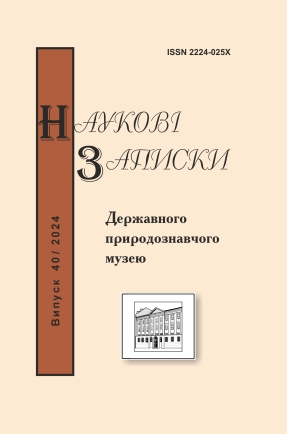Main
/
/
Shcherbachenko O.I., Sokhanchak R.R.
The morphological variability and photosynthetic activity of the epigeic mosses in the forest ecosystems depending on the ecological locality conditions // Proc. of the State Nat. Hist. Mus. - Lviv, 2024. - 40. - P. 125-132 DOI: https://doi.org/10.36885/nzdpm.2024.40.125-132 Key words: mosses, microclimatic conditions, morphological structure, life form, photosynthetic intensity The peculiarities of morphological variability and photosynthetic activity of the dominant epigeic mosses Polytrichastrum formosum, Plagiomnium affine and Atrichum undulatum depending on microclimatic conditions and the degree of anthropogenic changes in forest ecosystems were investigated. The morphological variability of mossy turfs in different ecological conditions of forest ecosystems was established, in particular, the influence of the level of humidity and the intensity of light on the morphometric parameters of mosses was revealed. The shoots and leaves of the studied mosses from the felling area were smaller and the density of turfs was higher compared to other localities. It was determined that a decrease in shoot height, leaf size, increase in leafiness and shoot density contributed to the preservation of water balance within the moss turf and the upper layer of the substrate. The dependence of the photosynthetic intensity of the leaves of dominant mosses on the moisture content of their turf and topsoil in the experimental plots of forest ecosystems was revealed. Changes in the functioning of the pigment system not only determined the photosynthetic activity of mosses in different localities, but also served as markers of their resistance to environmental conditions. The lowest intensity of CO2 assimilation was determined in the gametophyte of mosses in areas with recreational load. Probably, higher light intensity led to a violation of the water and temperature regime of plants, and thus to a decrease in their photosynthetic activity.
The morphological variability and photosynthetic activity of the epigeic mosses in the forest ecosystems depending on the ecological locality conditions // Proc. of the State Nat. Hist. Mus. - Lviv, 2024. - 40. - P. 125-132 DOI: https://doi.org/10.36885/nzdpm.2024.40.125-132 Key words: mosses, microclimatic conditions, morphological structure, life form, photosynthetic intensity The peculiarities of morphological variability and photosynthetic activity of the dominant epigeic mosses Polytrichastrum formosum, Plagiomnium affine and Atrichum undulatum depending on microclimatic conditions and the degree of anthropogenic changes in forest ecosystems were investigated. The morphological variability of mossy turfs in different ecological conditions of forest ecosystems was established, in particular, the influence of the level of humidity and the intensity of light on the morphometric parameters of mosses was revealed. The shoots and leaves of the studied mosses from the felling area were smaller and the density of turfs was higher compared to other localities. It was determined that a decrease in shoot height, leaf size, increase in leafiness and shoot density contributed to the preservation of water balance within the moss turf and the upper layer of the substrate. The dependence of the photosynthetic intensity of the leaves of dominant mosses on the moisture content of their turf and topsoil in the experimental plots of forest ecosystems was revealed. Changes in the functioning of the pigment system not only determined the photosynthetic activity of mosses in different localities, but also served as markers of their resistance to environmental conditions. The lowest intensity of CO2 assimilation was determined in the gametophyte of mosses in areas with recreational load. Probably, higher light intensity led to a violation of the water and temperature regime of plants, and thus to a decrease in their photosynthetic activity.
References
- Іващенко О.О., Іващенко О.О. 2019. Проблеми стресів у рослин і способи їх розв’язання // Вісн. аграрн. науки. № 7. С. 27−35. DOI: https:/doi.org/10.31073/agrovisnyk201907-04
- Ніколайчук В.І., Белчгазі В.Й., Білик П.П. 2000. Спецпрактикум з фізіології і біохімії рослин. Ужгород. 210 с.
- Польчина С. М. 1991. Методичні рекомендації до лабораторних і практичних робіт з ґрунтознавства. Чернівці. 60 с.
- Щербаченко О.І., Рабик І.В., Лобачевська О.В. 2015. Участь мохоподібних у ренатуралізації девастованих територій Немирівського родовища сірки (Львівська область) // Український ботанічний журнал. Т 72 № 6. С. 596–602.
- Bates, J. W. 1998. Is 'life-form' a useful concept in bryophyte ecology? Oikos, 82, 223–237. https://doi.org/10.2307/3546962
- Glime J. M. 2007. Bryophyte Ecology. Vol. 1. Physiological Ecology. Ebook sponsored by Michigan Technological University and the International Association of Bryologists. Accessed on: 03.11.2019 at: http://www.bryoecol.mtu.edu
- Glime, J. M. (2019). Bryophyte ecology. Vol. 1. Physiological ecology. Ebook sponsored by Michigan Technological University and the International Association of Bryologists. Website: http://digitalcommons.mtu.edu/bryop hyte-ecology1/ [accessed 7 January 2019]
- Kyyak, N.Y., Lobachevska, O.V., Rabyk, I.V., Kyyak, V.H. 2020. Role of the bryophytes in substrate revitalization on a posttechnogenic salinized territory // Biosyst. Divers. Vol. 28 N 4. Р. 419–425.
- Müller, S. J., Gütle, D. D., Jacquot, J.-P., & Reski, R. 2016. Can mosses serve as model organisms for forest research? Annals of Forest Science. 73. 135–146.
- Oishi, Y. (2018). Evaluation of the water-Storage Capacity of Bryophytes along an Altitudinal gradient from Temperature Forests to the Alpine Zone. Forests. 9(7) 433. https://doi.org/10.3390/f9070433
- Pressel S., Ligrone R., Duckett J. 2006. Effects of de- and rehydration on food-conducting cells in the moss Polytrichum formosum: a cytological study. Annals of Botany. Vol. 98. P. 67–76. https://doi.org/10.1093/aob/mcl092
- Proctor M.C.F., Tuba Z. 2002. Poikilohydry and homiohydry: antithesis or spectrum of possibilities? New Phytologist. Vol. 156. P. 327–349. https://doi.org/10.1046/j.1469-8137.2002.00526.x
- Proctor, M. C. F. 2009. Physiological ecology. In: Bryophyte Biology. Eds. B. Goffinet, A. J. Shaw, Cambridge: Cambridge Univer. Press. 237–268.
- Rabyk I.V., Lobachevska O.V., Kyyak N.Y., Shcherbachenko O.I. 2018. Bryophytes on the devastated territories of sulphur deposits and their role in restoration of dump substrate Biosystems Diversity, 26 (4). Р. 339−353. DOI:10.15421/011850
- Rice, S.K. (2012). The cost of capillary integration for bryophyte canopy water and carbon dynamics. Lindbergia. 35. 53–62.


